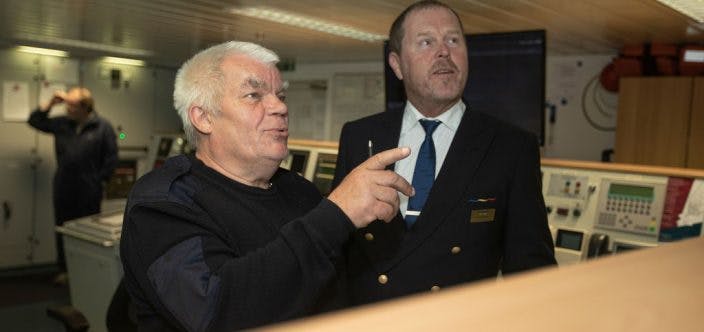Communications: The link between inclusivity and effective feedback
Feedback is a form of communication which is vital for growth and development; it helps to ensure operations are run safely and smoothly. On the surface it may seem like a simple task, however, giving effective feedback which enhances performance, takes finesse, and requires an inclusive workplace environment. Feedback and inclusivity support each other in creating a positive loop: An inclusive environment makes routine feedback easier, and valuable routine feedback in turn contributes to an inclusive environment.
Key points
- An inclusive environment makes feedback easier.
- Proper feedback contributes to an inclusive environment.
- We need feedback to develop and to make sure that we are running a safe operation.
- The most important thing is to start asking your personnel questions and listen openly to their answers.
Inclusive organisational structures
In discussing inclusiveness, we refer to organisational practices that create respect among colleagues and crew and nurture the feeling of being valued and heard. This inclusive workplace approach is crucial to facilitating effective feedback, whether it be ashore, onboard, or between the ship and the shore. A reader survey from the Harvard Business Review (2021) showed that among organisations ranked as very inclusive, 14% had an organisational culture in which learning was prioritised. On the opposite end of the scale, organisations which lacked inclusivity presented a culture based more on authority. The reader survey highlighted that inclusiveness encourages learning, and a learning culture makes people more open to giving and receiving feedback. Inclusivity also fosters psychological safety, which has been shown to be a foundation of a successful and safe business. Some typical features of a group with psychological safety are that personnel/crew feel included and dare to challenge and encourage each other with feedback.
Effective feedback
Feedback is not just about what you say; it is about how the recipient perceives the feedback. You might think that your feedback has been communicated clearly, but the recipient may interpret it in another way. The best way for your feedback to be effective is to learn how the recipient best understands and processes the information you want to give. You need to appreciate the recipient’s perspective. For example, it might be shaped by cultural background, prior knowledge, or current physical and mental state. The effectiveness of the feedback can be confirmed by asking for return feedback (essentially this means getting feedback on the feedback) to verify that there has been a correct understanding of the message communicated.
There are two main types of feedback: Constructive feedback, which shapes behaviour, and unconstructive feedback, which does not have any positive effects and in fact can make situations worse. It is important to remember that feedback needs to be a two-way interaction rather than a one-way delivery, and therefore, there should be a chance, for example, for a crew member to give feedback regarding the Master’s leadership and support. It is often difficult to give critical feedback due to the concern that it will cause offence or upset to the recipient and this can result in the feedback giver being less clear and direct in their message. Fear of the recipient’s reaction may also cause avoidance of giving any feedback at all. This is why corrective feedback needs to be practised so that those involved become comfortable with such routines.
What types of routine feedback are used to support psychological safety and inclusion?
Establishing regular feedback routines is the key. Informal or peer feedback can become a helpful part of daily working life. Sometimes informal feedback needs to be given immediately to avoid accidents and reduce risk. In addition to informal feedback, it is important to schedule formal and formative feedback sessions for the development of the crew. There could be several types of formal feedback: For example, briefings about safety or other topics are often routine, but there should also be one-to-one feedback meetings that more directly address the well-being and performance of shoreside staff and crew members. Formative feedback is used for monitoring a learning or development process. Regular self-evaluation feedback can also be used as a tool to monitor your own performance and is particularly useful in a high-risk environment such as onboard a vessel; Ask yourself “is there something that I could be doing better or safer”?
Successful feedback and inclusion rest on trust
The foundation for giving and receiving valuable feedback is trust. The feedback recipient must trust that the feedback giver is doing so out of care and means well. We give feedback because we want to make the working environment safe, and we want to encourage the advancement of skills. Misuse of feedback can be detrimental to the culture of an organisation and violates the foundation of trust. Look out for feedback that falls under the category of master suppression techniques, which is feedback that is utilised to manipulate someone. An example could be diminution, where you are talked down to as if you have less worth than the other person. Another common master suppression technique is the projection method, which plays on blame, and the feedback giver indicates that everything is the recipient’s fault.
Conducting an honest feedback discussion does not come naturally to everyone, meaning we need to train feedback processes where everyone has a chance to be heard. Some people have no problem giving feedback anytime about anything, while others may need encouragement and time to think it over. Whether we like it or not, everyone, including ourselves, is prejudiced in one way or another, but getting honest feedback helps us to widen our perspective. A key factor in giving and receiving valuable feedback is that there should be no judgement. Very few people are conscious of their own prejudices/biases because we often treat them in our minds as “facts.” Good practice is to be very honest with yourself and question your own beliefs about another person.
Handling feedback
To determine if someone is capable of handling feedback, we need to know what state of mind that person is in. Simplified, instead of the mind functioning optimally with full access to logical functions, people can go into states referred to as monkey brain and reptile brain.
Monkey Brain: When we are overwhelmed with difficult emotions, we use some of the same brain functions that we share with mammals, and it can be difficult to maintain our logical thinking and more complex mental maps. If you are planning to give a person feedback and you can tell that something is bothering them, it is best to make space to discuss whatever is burdening them first, so that the person is able to go back to thinking logically and process the feedback with full capacity. If the team has a good foundation of psychological safety and the individuals feel supported when they want to talk about something personal, it helps them to interpret other feedback as well.
Reptile Brain: When put under high-stress levels, our ability to think clearly becomes reduced and is overtaken by anxiety. This state requires fast and clear information, nothing more complex than straightforward communications such as yes and no answers. This state means that the person is not susceptible to feedback and their stressful situation needs to be taken care of before they can absorb and respond to any such feedback.
Both above states are natural reactions to different circumstances/pressures, but when you are going to give important feedback, try to identify the state of the recipient, and, if possible, help them manage the monkey and reptile brain states so that they can understand and process feedback effectively. You also need to make sure that your own brain is in the correct mode so that you have access to all logical and complex functions. In doing so, your feedback will have a higher chance of being communicated successfully.
Corrective feedback
Although we have discussed the importance of timing feedback to ensure that the recipient is in a good state to handle it properly, there is an exception: When corrective feedback is necessary you should not wait. For example, if there has been a significant wrongdoing then feedback should be delivered right away in a straightforward manner. Giving corrective feedback can feel uncomfortable and you may want to avoid it or wait, but this is a common mistake. This type of feedback is a pre-requisite for creating a trusting and honest conversation.
Where should you begin?
As a starting point, the most important thing is to begin asking your seagoing and shoreside personnel some questions to gain insight from them and make them feel involved. Dr Cecilia Österman is a well-known researcher and lecturer in sustainable working life. If you are looking for guidance on what questions to ask, you can find her expert advice here>




